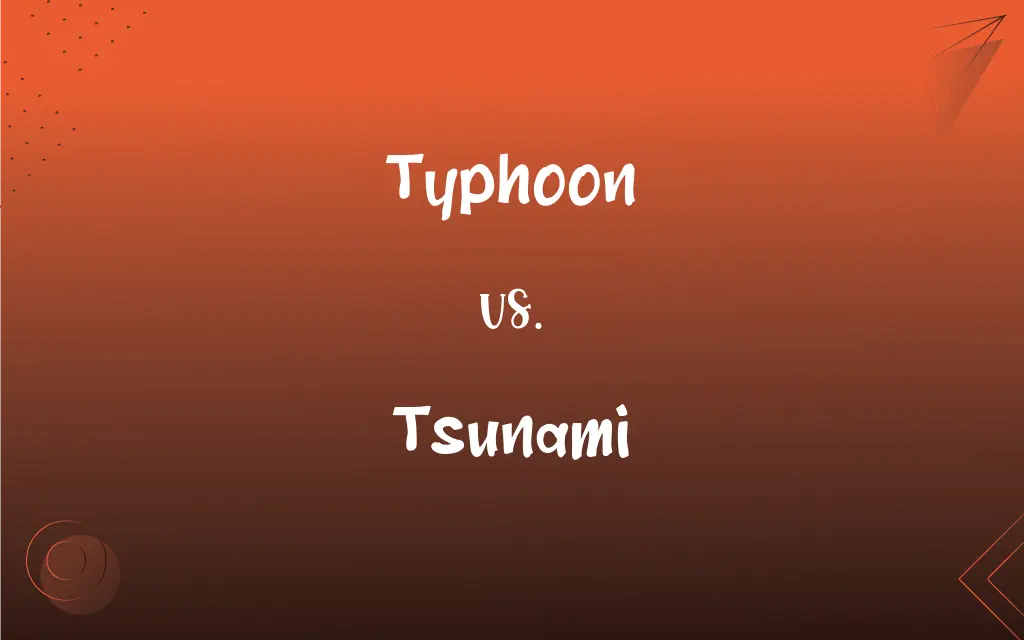Typhoon vs. Tsunami: What's the Difference?
Edited by Aimie Carlson || By Janet White || Updated on October 12, 2023
A typhoon is a tropical cyclone in the Northwestern Pacific, while a tsunami is a large sea wave caused by underwater disturbances, often earthquakes.

Key Differences
Typhoons and tsunamis are both powerful natural phenomena, but they have distinct differences. A typhoon is essentially a tropical cyclone that forms in the Northwestern Pacific Ocean. This storm system is characterized by strong winds, heavy rainfall, and low atmospheric pressure. On the other hand, a tsunami is a large and often destructive sea wave. Tsunamis are not weather-related like typhoons but are often triggered by undersea disturbances, primarily earthquakes.
When a typhoon develops, it starts over warm ocean waters, where warm air rises, causing a low-pressure system. This system attracts surrounding air, leading to a cyclonic action. The system intensifies as it draws more water vapor from the ocean. In contrast, tsunamis occur when there's a sudden and substantial displacement of water, often due to seismic activities on the ocean floor, such as earthquakes, volcanic eruptions, or landslides. This displacement causes waves to radiate outward, eventually reaching coastlines with devastating effect.
The damage caused by a typhoon is primarily due to its strong winds, which can cause destruction to structures and uproot trees, and heavy rainfall leading to flooding. Tsunamis, however, wreak havoc when their massive waves inundate coastlines, sweeping away everything in their path. While both can result in loss of life and property, their origins and characteristics are markedly different.
One significant point of confusion might arise from the term "tidal wave" which is often mistakenly used for tsunamis. Tidal waves are related to the gravitational interactions of the Earth, Moon, and Sun, while tsunamis are unrelated to tides. Typhoons, meanwhile, have no direct relation to either tidal waves or tsunamis, staying firmly in the realm of atmospheric phenomena.
Comparison Chart
Nature
Atmospheric phenomenon
Oceanic disturbance
ADVERTISEMENT
Primary Cause
Warm ocean waters and atmospheric conditions
Underwater disturbances, often earthquakes
Damage Mechanism
Strong winds, heavy rainfall, and storm surges
Massive waves inundating coastlines
Regional Terminology
Called "typhoon" in the Northwestern Pacific
Global term
Frequency
Seasonal, especially during warm months
Unpredictable, often after major underwater disturbances
Typhoon and Tsunami Definitions
Typhoon
A meteorological event characterized by low pressure and cyclonic winds.
The typhoon's intensity was measured by its wind speed and pressure drop.
ADVERTISEMENT
Tsunami
A large sea wave caused by underwater disturbances.
The earthquake triggered a tsunami that hit the shorelines.
Typhoon
An atmospheric disturbance specific to the Northwestern Pacific region.
The Philippines often experiences several typhoons each year.
Tsunami
Waves that can inundate coastlines, causing extensive damage.
After the tsunami, rescue efforts were launched immediately.
Typhoon
A tropical cyclone in the Northwestern Pacific.
The typhoon hit the coast, causing widespread damage.
Tsunami
A series of waves with long wavelengths and high energy.
The tsunami traveled across the ocean at incredible speeds.
Typhoon
A storm system with strong winds and heavy rain.
Residents were warned of the approaching typhoon.
Tsunami
An oceanic event resulting in massive waves.
Coastal towns were evacuated due to tsunami warnings.
Typhoon
A severe weather system similar to a hurricane or cyclone, based on region.
The typhoon's path was tracked by meteorologists for days.
Tsunami
A phenomenon often associated with seismic activities.
The volcanic eruption led to a tsunami alert.
Typhoon
A tropical cyclone occurring in the western Pacific or Indian Oceans.
Tsunami
A very large ocean wave caused by an underwater earthquake or volcanic eruption.
Typhoon
A weather phenomenon in the northwestern Pacific that is precisely equivalent to a hurricane, which results in wind speeds of 64 knots (118 km/h) or above. Equivalent to a cyclone in the Indian Ocean and Indonesia/Australia.
Tsunami
A very large and destructive wave, generally caused by a tremendous disturbance in the ocean, such as an undersea earthquake or volcanic eruption. Tsunami are usually a series of waves, or wave train.
Typhoon
(intransitive) To swirl like a hurricane.
Tsunami
(figurative) A large and generally unstoppable surge.
Typhoon
A violent whirlwind; specifically, a violent whirlwind occurring in the Chinese seas.
Tsunami
A huge destructive wave (especially one caused by an earthquake)
Typhoon
A tropical cyclone occurring in the western Pacific or Indian oceans
FAQs
How is a tsunami generated?
A tsunami is often caused by underwater disturbances, like earthquakes.
Can tsunamis occur in any ocean?
Yes, tsunamis can occur in any ocean, depending on the presence of seismic activity.
Is a typhoon the same as a hurricane?
No, they're the same phenomena but named based on region. Typhoons occur in the Northwestern Pacific.
How fast can a tsunami travel?
In deep water, tsunamis can travel at speeds up to 500-800 kilometers per hour.
What is a typhoon?
A typhoon is a tropical cyclone in the Northwestern Pacific.
How can we predict a typhoon's path?
Meteorologists use satellite data and weather models to predict a typhoon's path.
Are typhoons seasonal?
Yes, typhoons are more common during warmer months in the Northwestern Pacific.
Can a tsunami's height increase near the shore?
Yes, as a tsunami approaches shallow waters, its height can increase dramatically.
Can landslides cause tsunamis?
Yes, underwater landslides can displace water, generating tsunamis.
What causes the strong winds in a typhoon?
Warm ocean waters and atmospheric conditions lead to the cyclonic winds of a typhoon.
What's the difference between a typhoon's eye and its eyewall?
The eye is calm and clear, while the eyewall has the storm's strongest winds and heaviest rain.
Are tsunamis related to tides?
No, tsunamis are not related to tides. They're caused by underwater disturbances.
Can typhoons form in the Atlantic Ocean?
No, in the Atlantic they're called hurricanes.
How can communities prepare for a typhoon?
By monitoring weather updates, preparing emergency kits, and having evacuation plans.
Do all underwater earthquakes cause tsunamis?
No, only significant displacements of the ocean floor can cause tsunamis.
What is the main threat of a typhoon?
Strong winds, heavy rainfall, and storm surges are primary threats.
How do tsunamis differ from regular waves?
Tsunamis have longer wavelengths and are generated by large-scale disturbances.
Can we stop a typhoon?
No, typhoons are natural events that can't be stopped, but preparations can mitigate damage.
What areas are most at risk from tsunamis?
Coastal areas, especially near tectonic plate boundaries, are at higher risk.
How are tsunamis detected?
Using deep-ocean assessment systems and seismic activity monitoring.
About Author
Written by
Janet WhiteJanet White has been an esteemed writer and blogger for Difference Wiki. Holding a Master's degree in Science and Medical Journalism from the prestigious Boston University, she has consistently demonstrated her expertise and passion for her field. When she's not immersed in her work, Janet relishes her time exercising, delving into a good book, and cherishing moments with friends and family.
Edited by
Aimie CarlsonAimie Carlson, holding a master's degree in English literature, is a fervent English language enthusiast. She lends her writing talents to Difference Wiki, a prominent website that specializes in comparisons, offering readers insightful analyses that both captivate and inform.































































